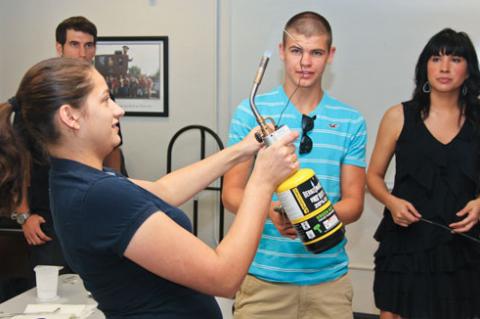Materials Magic Is in the Air at Summer Engineering Academy
The magic show is an integral part of Corral's undergraduate research program on high-temperature materials for aerospace and energy applications.

During the weeklong residential Summer Engineering Academy, high school students explore the varied careers offered by engineering by attending lectures and presentations related to the 13 engineering majors available at UA.
The UA students presenting the Materials Magic Show explain some of the curious properties of different materials by deep-freezing both old pennies and marshmallows in liquid nitrogen. The audience can then see how easy it is to shatter a frozen penny, and they get to eat marshmallows that have been chilled to minus 321 degrees Fahrenheit.
"Sparking children's interest in science and engineering is important to the future of engineering and the technology of the world," said Anne Ellis, a materials science and engineering junior and magic show presenter. Ellis is one of seven undergraduate students who have spent this summer doing research in Corral's lab.
Corral, whose research on high-temperature materials is funded by the National Science Foundation and the Air Force Office of Scientific Research, has established a group of undergraduate researchers who committed to summer research followed by a presentation of their results at a mini research symposium on Aug. 7.
Corral named the program SMART, for Southwest Materials Research and Training. In 2010 Corral became the first faculty member in the materials science and engineering department to receive an NSF Career award, funding from which supports the SMART program.
The Materials Magic Show, explained Corral, helps her group share its research with the community. "It also benefits students by putting them in a position to explain what materials science is and how our research enables new applications in aerospace," she said.
"Personally," Corral added, "I believe it is a responsibility of all scientists and engineers to reach out to our communities and explain what we do in research and how it affects their daily lives."
Ellis explained that before the magic begins, the young student audience learns about the main types of materials -- such as ceramics and glass, metals and polymers -- and how they are used in current technology. "Students learn about the properties of different types of materials and how every material, from the glass on their cell phone to the plastic in their glasses, has been engineered for that specific application," said Ellis. "Once the students understand some basics, the exciting magic can begin."
In addition to using liquid nitrogen to show how temperature affects materials, the magic show presenters heat memory alloys with a blowtorch to show how these metals can remember what shape they were before they were bent and coiled. The same blowtorch is used to heat a space shuttle tile until it glows incandescently hot on one side. Audience members are then invited to touch the non-heated side. Although the tile is only half an inch thick, it remains cool to the touch, demonstrating the essential thermal properties of the shuttle's protective tiles.
Magic Show Slide Show
For Ellis, who has been studying the properties of high-temperature ceramics, presenting the magic show is a bit of fun in a summer of serious research. "Having the opportunity to do research as an undergraduate is beneficial to my learning experience and it also prepares me for graduate schooling," Ellis said. "Working in a lab gives you hands-on learning where you can apply all that you have learned in lectures to the real applications of engineering."
The research also prepares Ellis and her SMART co-researchers for graduate school. "Learning how to complete research and write technical reports will benefit us greatly and gives us priceless experience," Ellis said.
Presenting the Materials Magic Show to the Summer Engineering Academy has a special significance for Ellis because she attended the summer camp herself.
"Seeing the presentation as a high school student, I know the effect it has on younger students and the effect it had on me," Ellis said. "After attending this camp I became very interested in engineering ... during my freshman year I wasn't sure what specific type of engineering to choose, but then I remembered the Materials Magic Show."
Ellis said the presentation on materials science and engineering sparked her interest so much that she decided to major in it. "It has been an excellent choice and doing materials science and engineering research has been a great opportunity," she said.
Ellis's co-researchers this summer are Victoria Marotto and Fangyuan Gai, both seniors at UA studying materials science and engineering; Leah Herlihy, a junior at UA studying materials science and engineering; Paul Neff, a fourth-year at UA studying materials science and engineering and aerospace engineering; Amber Powell, a junior at Missouri University of Science and Technology studying ceramic engineering; and Adam Ullah, a fourth-year at UC Irvine studying materials science and engineering and mechanical engineering.

